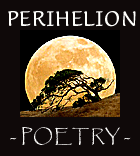Winning Poems for June 2013
Judged by Linda Sue Grimes
First Place
Yellowknife
by Helm FilipowitschBabilu
To my nephew, David Hare,
resident of Yellowknife,
who passed away in an airplane
accident, Resolute Bay,
August 20, 2011; survived by
his wife, three young daughters,
love and dreams.
Having gone to Yellowknife, though not
above the tree line and having walked
in Yellowknife on streets bisecting
the now and then and having seen
the scraping of the earth’s carapace
against a sky with clouds, water with
boats and planes two-legged at exactly
the demarcation point between
earth and air, I wonder how anything
can exist there that is not a playing card
flipped down on a table piled with chips,
an open bottle of vodka, a primed rifle,
the promise of an unborn child, chill
northern lights, a hand reaching for
a hand, the winter cold that cauterizes
pain, a desire extended beyond the snow,
into the conflagration of a ferocious love.
“Yellowknife” speaks to the mystery of how love and pain comingle. The things of this earth that catch the eye also resonate in the heart as this speaker remembers, “having walked / in Yellowknife on streets bisecting / the now and then.” The elements of earth, water, fire, and air provide the admixture that results in the turmoil felt in the human body, and that corresponding turmoil is dramatized in both the town and poem of Yellowknife as the speaker observes, “water with / boats and planes two-legged at exactly the demarcation point between /earth and air” and later engages a Whitmanesque catalogue featuring “an open bottle of vodka” and the “chill / northern lights.” The final image of “the conflagration of a ferocious love” comes to resemble “the winter cold that cauterizes / pain,” for which readers are grateful. --Linda Sue Grimes
Second Place
Folk Remedy
by Allen WeberFreeWrights Peer Review
You boil white willow to relieve my grippe.
Sassafras, horehound, and pennyroyal teas
can calm a cough; and dogwood bark kills fleas.
Feed cornsilk, steeped, to our bedwetting imp.
Poultice that wound with common summer weeds;
yarrow or jimson seeds should do the trick.
Press hard an iron key against your neck,
if unprovoked your nose begins to bleed.
A rhubarb necklace quells my bellyache.
Rhododendron cools Gran’s rheumatism;
on her shingles, rub blood from a chicken.
If moonlight darkens your beautiful face,
I’ll share your lips with passiflora vine,
a three-way kiss with bitter medicine.
The delightful “Folk Remedy” plays out in a finely structured Elizabethan-like sonnet that cobbles together the various uses of herbs and plants for their healing properties. The slant rimes in the quatrains highlight the nod to the traditional form, while providing just the right dollop of skepticism about the efficacy of the herbal remedies. The couplet featuring a sight rime that yields “a three-way kiss” juxtaposes passionate sweetness and the bitterness of medicine. The speaker completes the texture of familial closeness by bathing its miseries in soothing balms. --Linda Sue Grimes
Third Place
Describing Blue to My Colorblind Friend
by Teresa WhiteWild Poetry Forum
Blue is standing in the ocean up to your breastbone,
the surging base of the wave moving over you.
It is the scent of rain and rain itself.
Blue is the color of a black lab’s eyes
or the smudge of a bruise on your inner arm
that has no explanation.
Blue is lobelia cascading from a porch planter;
the color of leftover instant mashed potatoes,
the color of choice.
Blue is the complement of yellow,
the sky and sun. Blue is the stain
that won’t come out when the crime is done.
Blue is born with the pluck of a string
across an old cigar box. Blue is the color of company,
the three-piece suit, the taffeta dress.
Blue is the knitted cap for the male preemie,
the rubber stopper at the end of a feeding tube,
the color of hospital sweats, the sound of goodbye.
The speaker in “Describing Blue to My Colorblind Friend” translates the color “blue” into emotions called forth by the color. Blue can be soothing to the skin like “standing in the ocean up to your breastbone,” yet it can be the result of pain “the smudge of a bruise on your inner arm.” The speaker uses not only tactile and visual images to explain the color but also auditory, “the pluck of a string / across an old cigar box,” olfactory, “the scent of rain,” and gustatory, “leftover instant mashed potatoes.” The final image of “the sound of goodbye” being a feature of “blue” waxes consummately appropriate. The colorblind friend can be grateful for this montage of blueness that offers a useful sensory dictionary of this fabulous color. --Linda Sue Grimes

